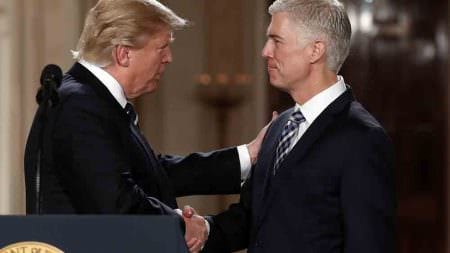By Roger J. Katz, Attorney at Law and Stephen L. D’Andrilli ~ Part 1


New York, NY -(Ammoland.com)- The Kolbe Case: Introduction
On February 21, 2017, antigun establishment judges of the U.S. Court of Appeals for the Fourth Circuit decided a case—one directly and negatively impacting the Second Amendment right of the people to keep and bear arms. The case Kolbe vs. Hogan, ____ F.3d ____ (4th Cir. 2017), 2017 U.S. App. LEXIS 2930 is the latest in a slew of cases coming down the pike since the late Justice Antonin Scalia penned the majority opinion in the seminal Second Amendment case U.S. Supreme District of Columbia vs. Heller, 554 U.S. 570, 128 S. Ct. 2783 (2008).
The high Court, in Heller, made abundantly clear that the right of the people to keep and bear arms is an individual right—a right unconnected to a person’s connection with a militia.
Two years later, question arose whether the Heller decision applies to the States. The U.S. Supreme Court, Justice Samuel Alito writing for the majority in the case McDonald vs. City of Chicago, 561 U.S. 742, 130 S. Ct. 3020 (2010), held that the individual right to keep and bear arms applies to the States no less so than to the federal government. The U.S. Court of Appeals for the Fourth Circuit obviously has clear disdain for the Second Amendment to the U.S. Constitution, and, concomitantly, disaffection for the Heller and McDonald cases that provide a firm foundation for the Second Amendment’s preservation and provide welcome relief to those Americans who wish to exercise their right under it.
Where To Begin?
Where do we begin on our analysis of the atrocious decision of the Fourth Circuit in Kolbe. The import of this awful decision rests, first, upon the majority’s disregard for the precedential holdings of Heller and McDonald. The majority shreds the legal principle of stare decisis, which requires courts to uphold prior decisions lest the foundation of our system of case law fall apart. The import of this absurd decision rests, second, on the Court’s clear contempt for the explicit fundamental right of the people to keep and bear arms, codified un the Second Amendment to the U.S. Constitution. And, this atrocious decision rests, third, on the majority’s clear rebuke of U.S. Supreme Court Justice Scalia’s legacy.
Why Is The Kolbe Case, In Particular, Critical To Those Who Wish To Safeguard The Right Of The People To Keep And Bear Arms Under The Second Amendment?
Since 2008, when the Heller decision became the Law of the Land, there have been several cases wending their way up through the various Circuit Courts that have dealt directly or tangentially, and disparagingly, with the Second Amendment. What makes the Kolbe case so important to those Americans who hold dear the Second Amendment to the U.S. Constitution is that the decision openly defies Heller.
One, the Kolbe decision amounts to a direct, frontal assault against the right of the people to keep and bear arms. Two, the decision is a disrespectful and unrestrained attack on the methodology that Scalia employed when the Justice wrote his opinion for the majority in Heller.
Now, the Fourth Circuit, writing its damning opinion in Kolbe, won’t admit its denigration of the Second Amendment and, by extension, its disrespectful attitude toward Justice Scalia. After all, the decisions of the high Court are the Supreme Law of the Land, and lower courts, State and federal, are legally bound to respect and to apply rulings, holdings, and reasoning of the high Court.
How Do Lower Courts Undermine Rulings and Holdings Of U.S. Supreme Court Cases They Do Not Like?
If a lower court doesn’t like a holding of the U.S. Supreme Court, it has weapons in its arsenal. Lower courts use these weapons against a U.S. Supreme Court holding if, one, the lower court disagrees with the decision of the high Court, and, two, if a lower court disagrees with the philosophy of law underlying the ruling of the high Court, and, three, if a lower court disagrees with the legal and logical methodology employed in support of the high Court’s ruling in a case.
One technique a lower court uses to undercut a high Court ruling is to argue a distinction in fact patterns. We see this in Kolbe. Of course, a reputable court would attempt to discern similarities in the facts of a case before it, before the court goes hither and yon, denying obvious similarity in fact patterns. A lower court should give maximum effect to a ruling of the U.S. Supreme Court but may feel less compelled to do so if it can, plausibly, demonstrate a distinction in fact patterns between the facts as presented in a case before the high Court and the facts as presented in a case being heard in a lower court.
The U.S. Court of Appeals for the Fourth Circuit, in Kolbe opined that the facts of the Heller case are wholly unlike those in Kolbe. The Court is wrong.
Why do we say that the Fourth Circuit is wrong? First, the critical facts in Kolbe are virtually identical to those in Heller. A couple of Plaintiffs in Kolbe, as with the Plaintiffs in Heller, are individuals who are under no disability. They are average law-abiding, rational, sensible, sane American citizens whose right to own and possess firearms is undeniable. Second, the D.C. Government in Heller, and the Maryland State Government in Kolbe, both enacted laws to ban outright an entire category of firearms that American citizens traditionally and commonly employ for self-defense.

In our analysis of the Kolbe case, to follow, we will demonstrate how the U.S. Court of Appeals for the Fourth Circuit attempts to skirt clear U.S. Supreme Court precedent to ignore and undercut Heller and, in so doing, allows stand a restrictive Maryland firearms law that is unconstitutional and inconsistent with the Heller decision. The sad result is that average, law-abiding, sane American citizens who seek to own and possess firearms they had traditionally owned and possessed for decades, can no longer do so.
Thus, notwithstanding that the gun ban enacted in Maryland applied originally only to residents of the State of Maryland and to those passing through the State, the Fourth Circuit decision directly impacts the right of American citizens in the five States that comprise the Fourth Circuit: North and South Carolina, Virginia and West Virginia, and Maryland.
All individuals of these five States are now denied their right to keep and bear arms, guaranteed under the Second Amendment because they are denied their right to keep and bear an entire category of firearms they had traditionally owned—firearms that the American public commonly owns and possesses for self-defense.
Second, lower courts that harbor a strong disdain for the ruling in Heller and who thereby harbor a disdain for the Second Amendment to the U.S. Constitution, misconstrue—whether deliberately and callously or, if not deliberately and callously, then certainly carelessly and recklessly—the reasoning of the high Court. The lower court substitutes for the high Court’s reasoning, its own flawed reasoning—reasoning, that lends support to a conclusion the lower court seeks, rather than to the conclusion the high Court requires that the lower court reach.
In Kolbe, the Fourth Circuit applied a standard of review that the majority in Heller, and, in particular, Justice Scalia, who wrote the opinion, had rejected outright. We explain this in detail when we proceed with a comprehensive case analysis of Kolbe.

Third, lower courts that harbor a strong dislike for the Second Amendment and who attempt to meander around the clear and cogent reasoning, rulings, and holdings of the high Court often consider matters wholly outside the purview of the law, namely political matters. This clouds judicial judgment, as application of the law to the facts of the case is colored by personal biases and feelings rather than by reasoned, seasoned, Judicial thought. In the process, judicial neutrality and integrity is lost as partiality enters into judicial decision-making. Thus, the rule of law is denied one or the other party to a lawsuit.
As we proceed with our analysis, we make abundantly clear the extent to which the U.S. Court of Appeals for the Fourth Circuit considers matters outside of legal constraints—matters that have no legitimate, legal, or, for that matter, logical connection to or bearing on how a case ought to be decided.
The dreadful decision in Kolb, also operates as a warning to the U.S. Senate Judiciary Committee. The Committee better get cracking on holding a confirmation hearing of the President’s nominee, Neil Gorsuch to the U.S. Supreme Court. It must do so because the Kolbe case must not stand unchallenged. The antigun forces have slowly chiseled away at Heller through other poorly reasoned and decided cases. But, Kolbe is most dire because this decision, more so than other Second Amendment cases coming down since Heller and McDonald, constitutes a direct assault on U.S. Supreme Court precedent, and, if allowed to stand, unchallenged, severely weakens the Second Amendment and will undoubtedly embolden other antigun federal Circuit Courts that wish to chisel away at Heller.
Make no mistake, Plaintiffs in Kolbe vs. Hogan will take this case to the U.S. Supreme Court. They must, for the decision here is antithetical with the holdings set forth and reasoning evinced in the seminal Heller and McDonald cases.
With Gorsuch on the high Court, the Justices will likely vote to hear this case. The Justices must hear this case. The case must be overturned, lest the legal precedents of Heller and McDonald be continually ignored by State Governments.
What is Kolbe vs. Hogan really all about and why are the issues presented in it critical to the safeguarding of our bill of rights? We explain in Part 2 of this series.
About The Arbalest Quarrel:
Arbalest Group created `The Arbalest Quarrel’ website for a special purpose. That purpose is to educate the American public about recent Federal and State firearms control legislation. No other website, to our knowledge, provides as deep an analysis or as thorough an analysis. Arbalest Group offers this information free.
For more information, visit: www.arbalestquarrel.com.

The 4th Circuit incorrectly quoting the 2008 Supreme Court in Heller:
“weapons that are most useful in military service — M-16 rifles and the like — may be banned” without infringement upon the Second Amendment right. See 554 U.S. at 627.
Found in the second paragraph on page 35:
https://www.ca4.uscourts.gov/Opinions/Published/141945A.P.pdf
Appears the majority of the 4th Circuit judges in the case above are either intentionally deceiving or illiterate:
What the Supreme Court in Heller actually said is found starting in the last paragraph on page 55 on this link:
https://www.supremecourt.gov/opinions/07pdf/07-290.pdf
In 1939 when the SCOUS was considering the MILLER case and 1934 NFA, the Court was sure of only one thing, contemporary military rifles were included in the scope of the Second Amendment. In 1939 the BAR and the Thompson were contemporary military rifles. As far as machine gun development, as far back as te Revolutionary Wat, 1775 rifles were ganged into batteries that could be fired by one man. Development of the self-contained cartridge in the early to mid-1800 and then smokeless gun powder were the only technological pieces needed to further develop the ganged rifle to an M16.… Read more »
What would be nice is if there was a way to measure judicial performance. If some percentage of rulings are subsequently reversed that court is disbanded and reconstituted.
This decision follows Hellen’s process of deciding what gun would be protect. They didn’t have any form of automatic weapon in 1789.
Uh, yes they certainly DID have an automatic rifle back then. Prime example: the Girandoni rifle (https://en.wikipedia.org/wiki/Girandoni_air_rifle), which became available appox 1779. It could fire rapidly from a 20-round magazine. (This rifle was especially famous for its use on Lewis & Clark’s long expedition) All firearms are protected for individual use under the Second Amendment except those that are *both* dangerous and unusual (as ultra-clearly spelled out in the Heller decision). Modern sporting rifles such as the AR-15 are some of *the* most commonly-owned rifles in the U.S. (tens of millions of them), so they are far from unusual. They… Read more »
The HELLER case was limited to the question about the law in the city of Washington and the District of Columbia.
Rifles were not an issue, except for the W.DC. law on storage.
To deliberately misinterpret a SCOUS decision should be an impeachable offense. All the judges on the 4th, 9th and other district courts should have to justify such decisions.
A life time appointment should not cover judicial fraud, only ignorance or accideental error.